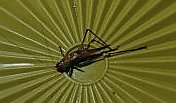
Orchelimum agile
(DeGeer)
By
Jason Hill
The Agile Meadow Katydid
|
|
|
Conocephaline
|
Orchelimum
|
Orchelimum agile

Identification
Orchelimum agile was first described by De Karel Geer in his 1773 book; Memoires pour servir a líhistore des Insectes. This book can only be found in Europe, though. J. Rehn and Morgan Herbard researched Orchelimum in 1915 and published their finding in the American Entomology Society. They collected a multitude of samples from Conwells, Pennsylvania all the way south to Live Oak, Flordia. This species can be seen at the University of Georgiaís Natural History Museum and I would like to thank Dr. Cecil Smith for helping me identify these tricky Katydids!
The Oprchelimum agile are medium sized for their genus and a yellow green color. The tegmina surpass the abdomen by 3mm and the wings by 2mm. The hind femora have one to five defensive spines on them (Blatchley 1920). Figure 1 shows the difference between the cercus (a paired appendage at the end of the abdomen) of an Orchelimum agile (a) and an Orchelimum vulgare (b). Figure 2 shows the difference in the pronotum (shield like covering at the front of the thorax) of an Orchelimum agile (a) and an Orchelimum vulgare (b).


Sketches by Jason Hill
Keying out the Orchelimum agile is very difficult. For a very detailed key refer to W.S. Blatchleyís Orthoptera of Northeastern America pages 537-539.
Geography

The map vaguely depicts the range of Orchelimum agile. The northern boundaries are in southern New Jersey and across through northern Illinois. They are found as far west as central Kansas. Orchelimum agileís southern boundary is southern Florida (right above the everglades) and across through the Mississippi valley in Louisiana.
|
Orchelimum agile |
||
|
AREA |
STATUS |
REFERENCES |
|
North America |
Yes |
Rehn & Morgan, 1915 Blatchley, 1920 |
|
Eastern North America |
Yes |
Rehn & Morgan, 1915 Blatchley, 1920 |
|
Southeastern United States :AL AR DE DC FL GA KY MD NC SC TN VA WV |
Yes |
Rehn & Morgan, 1915 Blatchley, 1920 |
|
Southern Appalachian States: AL GA KY MD NC SC TM VA WA |
Yes |
Rehn & Morgan, 1915 Blatchley, 1920 |
|
Coastal Plain |
Yes |
Rehn & Morgan, 1915 Blatchley, 1920 |
|
Piedmont |
Yes |
Rehn & Morgan, 1915 Blatchley, 1920 |
|
Blue Ridge Mountains |
Yes |
Rehn & Morgan, 1915 Blatchley, 1920 |
|
Great Smoky Mountains National Park |
Yes |
Rehn & Morgan, 1915 Blatchley, 1920 |
|
Ridge and Valley |
Yes |
Rehn & Morgan, 1915 Blatchley, 1920 |
|
Cumberland Plateau |
Yes |
Rehn & Morgan, 1915 Blatchley, 1920 |
|
Central Arch |
Yes |
Rehn & Morgan, 1915 Blatchley, 1920 |
|
Georgia |
Yes |
Rehn & Morgan, 1915 Blatchley, 1920 |
|
Clarke County, Georgia |
Yes |
Jason Hill, Pers. Ob. |
|
Samís Farm |
Common |
Jason Hill, Pers. Ob. |
|
Old Field |
Common |
Jason Hill, Pers. Ob. |
|
Wetland |
Probably |
Jason Hill |
|
Woods |
Probably |
Jason Hill |
|
1-Hectare Plot |
Probably |
Jason Hill |
Natural History
Orchelimum agile are commonly found in open spaces within a forest, but have been found in a variety of habitats. Specimens have been found in grassy bogs, headwaters of streams, goose grass, crab grass, foxtail-grass, and saw grass communities (Fox 1917). The agile meadow katydids eat the plants in the grasslands using their sharp mandibles and long maxillary palpi to dig into plant tissues and eat the seeds of the grass. Orchelimum agile lay their eggs at the base of tall plants in the meadow and, when hatched, undergo an incomplete metamorphous (Bradley 1920). The song of the Orchelimum agile has been observed to make a rapid sound like "zee-e-e-e-e" for about eight seconds then pauses and starts over (McNeil 1891).
How to Encounter Orchelimum agile
Orchelimum agile occur at Samís Farm. I would imagine they are quite common since I actually caught one. The adult seen in my picture was actually caught below the yellow quadrant near where the wetlands begin. I noticed some juvenile katydids that appeared to be in the Orchelimum genus in the tall grass where the trail goes into the woods. If trying to capture one of these beasts make sure to bring a net.